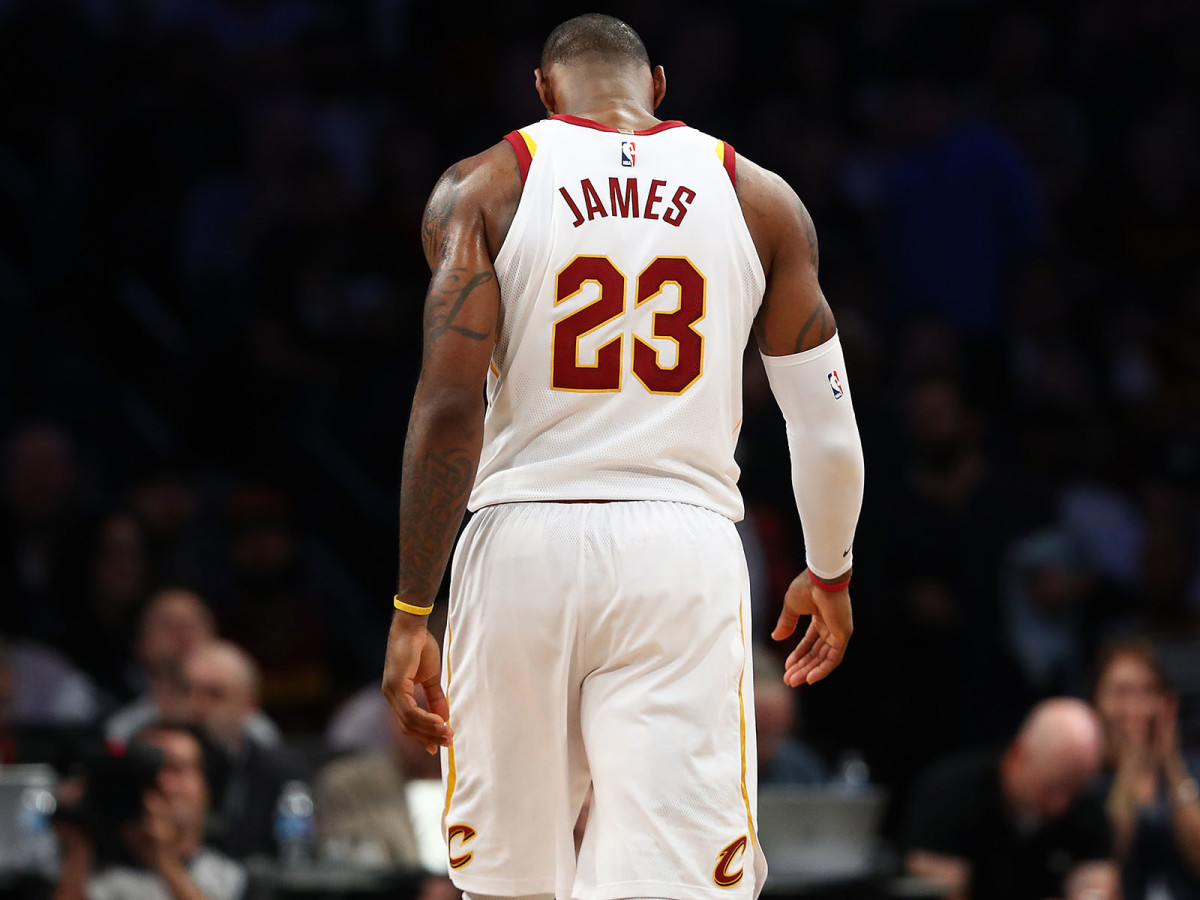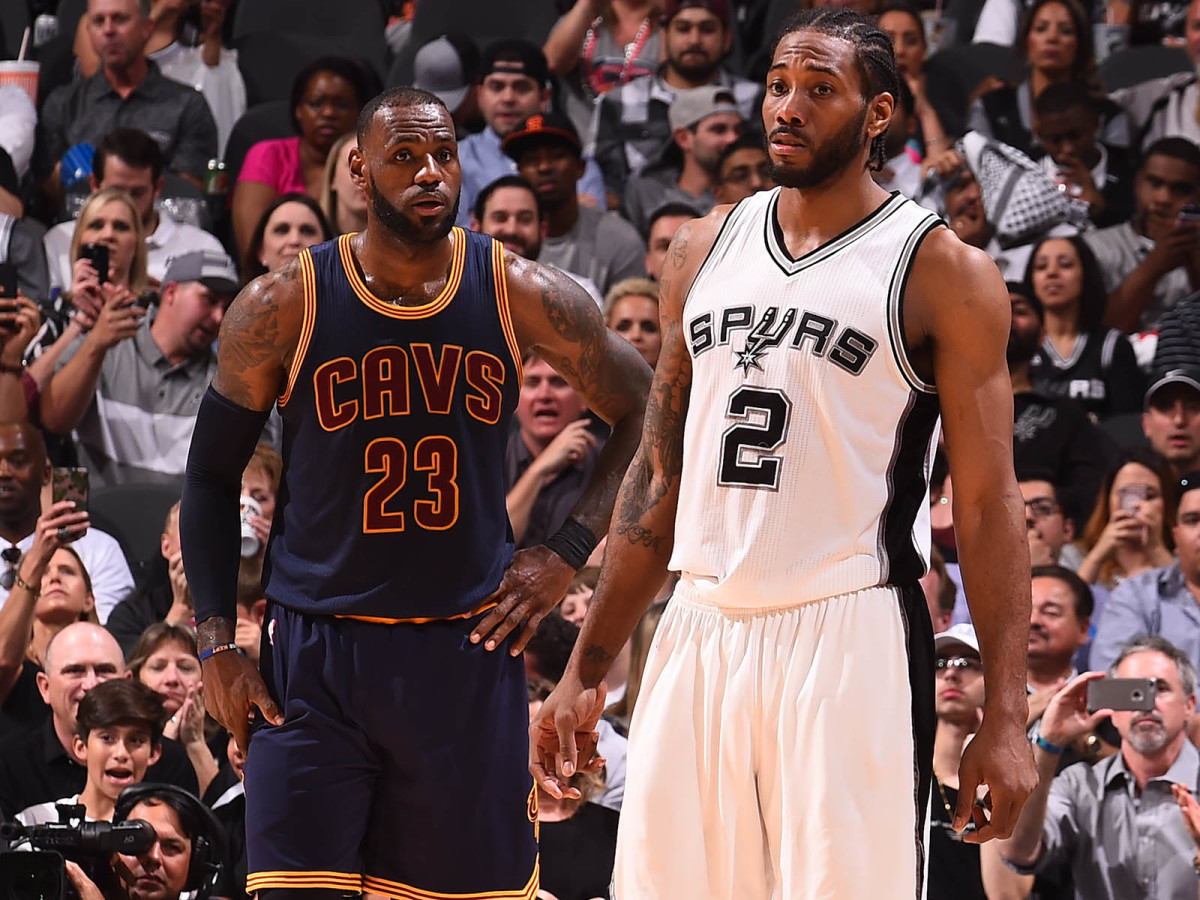The Decision III: Where Will LeBron Go in 2018?

The television camera zoomed in on LeBron James during the closing stages of a 17-point loss to Indiana on Wednesday, and the four-time MVP looked like he was doing his absolute best to suppress his inner Bob Knight. His Cleveland teammates smartly left the seats to his left and right unoccupied, granting a buffer for James to stew in silence. A team meeting, an extended practice and a Halloween party had somehow failed to generate an overnight fix for one of the league’s worst defenses, and the Cavaliers were about to suffer their fourth consecutive defeat to a 2017 lottery team.
No stranger to slow starts throughout his career, James told reporters a few days prior that it was still far too early in the season to panic. Even so, life has come at him awfully fast: Kyrie Irving’s trade request shattered James’s hand-crafted Big 3, Isaiah Thomas’s hip injury has left him without sufficient playmaking help, and his aging supporting cast is full of minus defenders who have made winning more of a chore than it should be. The Finals are still seven long months away, and yet James, who turns 33 next month, again ranks among the league’s leaders in minutes played because Cleveland’s offense simply can’t function without him. To add injury to the insult of a demoralizing losing streak, the Cavaliers announced Thursday that starting center Tristan Thompson will miss at least three weeks with a calf strain.
Though James continues to post individual numbers (25.6 PPG, 7.3 RPG, 8.9 APG) that are unmatched by any other player in the league, his tried-and-true blueprint for championship contention—three stars and a bunch of old-head role players—has never felt more outdated. Indeed, Cleveland’s early-season struggles offer some valuable lessons as to how James should alter his strategy and shift his priorities as he approaches The Decision III next summer.
When James left Cleveland for Miami in 2010, he sought to maximize his fame and his chances at winning a first championship. Upon his 2014 return to Cleveland, he sought to reclaim his hometown hero status while strengthening his organizational influence and maxing out his earning power. In Miami and now in Cleveland, James accomplished his primary objective before age and short-sighted roster moves left him with depleted rosters.
A LeBron James Team Shouldn’t Be This Sad to Watch
As July 2018 draws closer, James’s goals remain cut and dry: To bolster his legacy by adding to his ring count and to overtake Michael Jordan as the "Greatest of All Time." This week, James’s longtime business partner Maverick Carter downplayed longstanding rumors that James might sign with the Lakers next summer to expand his business and entertainment empire. “Could he sell a few more sneakers if he was in a gigantic market like Boston or Chicago or New York or L.A.y. ? Maybe,” Carter told The Rich Eisen Show. “But not as much as if he wins. What matters the most is if he wins.”
To win like he wants to win, James must swallow his pride on two fronts: He must admit that he needs more help than he’s become accustomed to, and he must find an organization with the structure and leadership personalities necessary to sustain success at Golden State’s level.
While Cavaliers owner Dan Gilbert has consistently shown the willingness to spend and GM Koby Altman displayed quick thinking throughout the summer, the long-term outlook in Cleveland is bleaker now than at any other points since his 2014 return.

The Cavaliers don’t have an ideal five-man lineup to match up with the Warriors’ best looks, they are facing a massive luxury tax bill for the foreseeable future, they have made major salary commitments to Love, Thompson and J.R. Smith, they will need to pay Thomas to avoid a major hole at point guard, and they must be ready to present James with the contract of his choosing next summer. Cleveland clearly needs to get younger, more athletic and more versatile, but Altman is stuck behind the 8–ball thanks to a series of win-now moves, a clogged cap sheet, and Irving’s abrupt exit. Even if Altman took drastic action by trading his best asset, the Nets’ 2018 first-round pick, for a star at the trade deadline, Cleveland would face another round of rushed gelling before the playoffs and all of its other long-term problems would still linger.
The last four seasons should lead James to this conclusion: Beating the Warriors will require superstar teammates, but also an organizational steadiness and vision that have often eluded the Cavaliers.
Gilbert deserves plenty of blame, to be sure: He wrote The Letter, he hired David Blatt, and he gave James the perfect excuse to leave next summer when he decided not to re-sign GM David Griffin. But James must look in the mirror and re-think his strategy of signing one-year and two-year deals too. Yes, he boosted his annual salary and applied constant pressure to Gilbert to ensure that the owner remained financially committed and aggressive. At the same time, his practice has backfired, as the possibility of his departure hangs over the organization and stands as the best reason for Irving to have forced his way to Boston. One foot in and one foot out is no way for James to keep pace with a budding Bay Area dynasty.
Not only should James sign a long-term contract next summer—thereby fully committing to his new teammates and granting his GM the ultimate recruiting tool—he should strongly consider taking an even steeper discount than he accepted when he teamed up with Dwyane Wade and Chris Bosh in Miami.
This suggestion is admittedly unjust. James is the sport’s best player and biggest star, and he’s worth far more to any NBA team than the maximum allowable salary. Unfortunately, he’s also trying to compete with a Golden State team that possesses a core of four stars who are under 30 and who will likely remain together for years to come. Kevin Durant already took a substantial discount last summer, one or more of his star teammates could theoretically follow suit, and the Warriors’ owners aren’t exactly penny-pinchers. One practical way for James to find himself with more help than he currently has—whether by opening up more desirable free-agency destinations or by giving his next GM more flexibility to fill out the rotation—is to take a pay cut.
Finally, James should seek out an organization with demonstrated alignment between its ownership, management and coaching staff. Cleveland’s rocky start can be attributed to a lack of a system to fall back on—other than James himself—and to destabilizing turnover on the bench and in the front office.
Golden State survived an extended injury to Durant down the stretch last season. Houston hasn’t really skipped a beat without Chris Paul. San Antonio, the NBA’s steadiest winner for two decades, managed to reel off a 4-0 start without Kawhi Leonard. Despite a flipped-over roster, Boston has recovered beautifully since Gordon Hayward’s opening-night injury. The Steve Kerr/Bob Myers, Mike D’Antoni/Daryl Morey, Gregg Popovich/R.C. Buford and Brad Stevens/Danny Ainge partnerships are all central drivers of that stability. Cleveland, by contrast, can only turn to James during hard times, in part because that’s the way James has preferred it and in part because of Gilbert’s misfires.
Casting James as alpha and omega has been a fruitful approach for most of his prime, but it’s bound to deliver diminishing returns as he ages. How much happier would James be right now if he had San Antonio’s cast of disciplined defenders around him? Or, if he could spread his playmaking wings in Houston’s diabolical offensive system? Or, if he had Stevens lightening his load by consistently squeezing the most out of anonymous role players? How much happier would he be if he played for an organization that didn’t need to play him 37 minutes a night, or one that—gasp—had a track record of winning 50+ games while carefully managing the minutes of its older stars?
James is too stubborn, talented and savvy to concede these points in November, and rightfully so. There’s plenty of basketball left and Cleveland will surely pick up its quality of play. But the problems that are haunting him now—a lack of cohesion, a top-heavy roster, ill-fitting lineups short on two-way players, and limited cap flexibility—are the same problems he should seek to avoid while selecting his next stop.
Assuming Golden State and Boston are out due to unavoidable personality conflicts, there are only two potential landing spots that check all the boxes by delivering proven owners, empowered coaches, GMs that have assembled well-fitting rosters, superstars already on hand, and clear styles of play: San Antonio and Houston.
Getting to either spot would be tricky. San Antonio would need to say goodbye to its 2018 free agents and cut additional salary, reversing course somewhat after its recent commitments to LaMarcus Aldridge and Pau Gasol. Houston would need to shed rotation mainstays like Ryan Anderson, Eric Gordon and Trevor Ariza. The Decision I and The Decision II both proved, though, that tricky logistics can be worked out and mountains can be moved to accommodate James’s arrival.
With the Spurs, James would get to play alongside a Durant-stopper in Kawhi Leonard and play for a coach in Gregg Popovich who can match his basketball IQ. He would coast to winning seasons and be able to count on a supporting cast that always delivers a whole greater than the sum of its parts.

In Houston, he could unite with longtime friend Chris Paul and step into Mike D’Antoni’s “All three-pointers, all the time” attack. In James, Paul and James Harden, the Rockets would have a strong case for the best passing trio in NBA history, and shooters would flock to play alongside them on minimum deals. “LeBron + 4 shooters” is a proven formula, and taking it to D’Antoni’s extremes would be a sight to behold, placing James back on the cutting edge.
Whether in San Antonio or Houston, James would also be better suited to take the next logical step in matching up with Golden State as he ages: shifting more of his minutes to small–ball center. A James/Leonard frontline is the best counter imaginable to Golden State’s pairing of Durant and Draymond Green, while Rockets lineups built around James, Paul, Harden and a pair of three-and-d wings would have the potential to go point-for-point with the Warriors. All that energy spent fretting over whether Love or Thompson can stay on the court during the Finals? Poof, gone. And the burden of being the primary defender on Durant? Lessened, at least somewhat.
Maybe James eventually decides that this is all too radical, that the Cavaliers’ struggles aren’t drastic enough to blow up his whole life, that he doesn’t want to sacrifice his earning power or leverage, or that pursuing his off-court interests in L.A. really is too hard to resist.
Hopefully not. Carter was correct to suggest that winning is in James’s absolute best interest—both financially and legacy-wise. Each new championship from here on out exponentially increases his fame, fortune and post-career staying power. Look no further than Kobe Bryant’s last decade to see the escalating power of a fourth and fifth ring.
As James rides the waves during another choppy regular season, he should internalize the many virtues of a “less is more” approach. Less year-to-year uncertainty, less organizational turmoil, less focus on quick fixes, and, yes, less salary could prove to be the right combination for derailing the Warriors’ dynasty.
Smart organizations with savvy executives and All-NBA sidekicks are ready to act if he ultimately reaches that conclusion.
